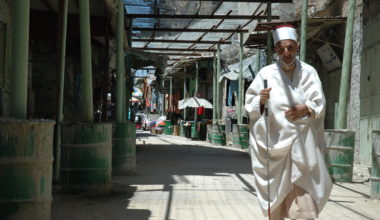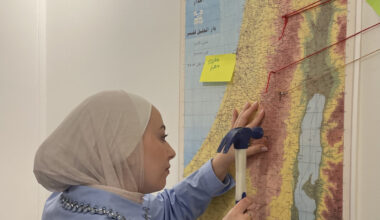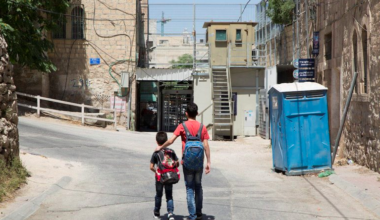
By Emilio Distretti (SOAS), former Fellow at CBRL’s Kenyon Institute and Travel Grant recipient.
In 2017 I co-authored with Fabio Cristiano (Lund University, Sweden) the article “Along the lines of the Occupation: Playing at Diminished Reality in East Jerusalem”. The article explores how new technologies and media – specifically online gaming (PokemonGo) – operate in the colonial setting, as tools for enhancing separation in the context of a politically, socially and ethnically segregated city.
In 2018 Fabio and I embarked on a new project, that aims to take the discussion further and expand our research to explore the relation between aesthetics, digital technologies and the colonial present in Palestine.
We decided to explore the representational features of algorithms in social media and apps: by expressing, organising, and capturing the aesthetic experience of users, algorithms shape new relations between power and representation.
Our research explores the impact that an ‘aesthetics by algorithms’ – i.e. the visual canons produced by these intelligent machines – has on questions of inequality and injustice in Israel/Palestine. Working within the tradition of critical studies on the relationship between power and cartography, this research explores the ways in which algorithms manifest themselves operationally and create an aesthetics of appearance and disappearance, by concealing traces of state violence and oppression. In order to do this, we ask the following questions: in what sense aesthetics by algorithms is embedded to ideology and power structures? To what extent algorithmic aesthetics reinforce inequality, segregation and a logic of dominance?
To answer these questions our research considers the way in which algorithms in social media, social networks, apps and online services embed to Israel’s Zionist ideology. We argue that algorithms reproduce and reinforce power structures. They operate as the link that joins Israel’s technologies of government (military/civilian) to users’ interactions. We look at this through two specific case studies around popular apps and online services, in the way they organise power and dominance through representational forms: Facebook (social and media), and Waze (social and navigation).
In the spirit of ‘predictive policing system’, Israel uses algorithms as a way to monitor/control early warning of Palestinian violence. This culminated in the recent application of an algorithmic scanning of Palestinians’ social media content. They are managed and run through governance partnerships including internet service providers, state authorities, and internet companies (Facebook, etc.). Besides scanning some specific words, the algorithms intercept content which has a large outreach. In other words, some users are neutralised not for ‘what’ they share, but rather for their popularity: algorithms seem to acknowledge users’ subjectivity and identity in relation to their social networks. The algorithm focuses on statuses, comments, and pictures in order to identify content that is critical of Israeli policies or considered an “incitement to violence”. Leading to the arrest and detention of around eight hundred Palestinians since 2015, the justification for this monitoring lies in the assumption that online incitement constitutes an early-warning of crime, thus preluding violence. Palestinian human and digital rights organisations (such as 7amleh and the Palestinian Centre for Human Rights) reported how the algorithmic settings also filter content – such as poetry, journal articles, and political statements – that criticise Israeli occupation without any direct reference to violence. As shown in the emblematic case of poet Dareen Tatour, – who has been convicted and imprisoned by the Israeli authorities because one of her poems circulated widely on the web has been flagged for inciting violence – there appears to be a direct correlation between popularity and punishment: the more users like, share, and circulate content, the more severe the punishment will be. Algorithms somehow work as online checkpoints, filtering content and reporting it to authorities in the event that these are perceived as worthy of ‘attention’.
Our second case-study looked at navigation apps. Originally developed by an Israeli start-up and later bought by Google, Waze is a popular community-based traffic and navigation smartphone and tablet application. Waze is considered to be the cause of several controversies that involve Israeli military strategists and national security. In 2015 at the time of the Third Intifada, Waze wrongfully featured certain areas of East Jerusalem as Areas A or B in order to prevent Israeli Jews from accessing ‘danger zones’. According to the 1993 Oslo agreements, areas A and B define territories located in the West Bank under the (partial) Palestinian Authority’s security and civil control. Jerusalem’s mayor addressed Waze’s CEO to contest this claiming that these areas are within Jerusalem’s municipal boundaries and under full Israeli control. In 2016, an Israeli Defence Forces (IDF) vehicle, was using Waze to navigate when it erroneously entered the Qalandiya refugee camp (between Jerusalem and Ramallah) provoking a reaction of the Palestinians from the camp. One Palestinian was killed, while the camp was put under siege by the Israeli military. Following these events, Israeli army officers gave Waze’s representatives a field tour in the West Bank to enable them to update their driving directions to prevent Israeli civilians and military personnel entering Palestinian towns and villages in area A. This example demonstrates how questions of ‘digital representation’ are embedded in the question of sovereignty, and the way algorithms produce digital filters that organise and prevent mobility.
A longer version of this research will be published in the forthcoming book “Fear and Loathing of the Online Self” by Palgrave Macmillan in 2019.
Emilio Distretti is a researcher and educator. Emilio is Postdoctoral Fellow in History and Theory of Architecture and Urbanism, at the Department of Urban Studies, University of Basel (Switzerland). Prior to this, he taught at SOAS, University of London, at the Department of Politics and International Studies. Between 2015-2017 Emilio was Postdoctoral Fellow at the Kenyon Institute (Council for British Research in the Levant) in East Jerusalem and Assistant Professor and Director of the Urban Studies and Spatial Practices program at Al Quds Bard College for Arts and Sciences, in Abu Dis in the Occupied Palestinian Territory. Emilio’s research takes on interrelated avenues on architecture, material culture, politics of space, human rights, migration in the colonial and post-colonial Mediterranean (Italy, North Africa and the Levant).
The views expressed by our authors on the CBRL blog are not necessarily endorsed by CBRL, but are commended as contributing to public debate.















